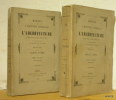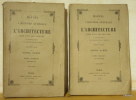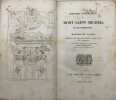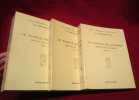-
Type
Any type (2)
Art print (7)
Book (30940)
Disk (1)
Drawings (7)
Engraving (9)
Magazine (129)
Old papers (1)
Photographs (14)
Posters (4)
-
Latest
Last 24h (1)
Last 3 days (9)
Last month (229)
Last week (131)
-
Language
Dutch (1)
English (54)
French (31013)
German (6)
Italian (18)
Japanese (2)
Portuguese (9)
Spanish (11)
-
Century
16th (16)
17th (56)
18th (209)
19th (1539)
20th (9203)
21st (1661)
-
Countries
Belgium (9485)
Brazil (7)
Canada (108)
China (3)
Côte d'Ivoire (67)
Denmark (218)
France (18162)
Germany (1)
Greece (1)
Italy (37)
Switzerland (3025)
-
Syndicate
ALAC (99)
CLAM (42)
CLAQ (94)
CNE (3)
ILAB (10651)
NVVA (1161)
SLACES (1161)
SLAM (8123)
SNCAO (9)
L'Architecture Et La Construction PratiquesMises à la portée des gens du monde, des élèves et de tous ceux qui veulent faire bâtir
rmin Didot DIDOT PARIS 1881 / 649 pp IN8 Reliure dos basane verte, titre or (passé ) , plats marbrés, ensemble usé et élimé avec manque de basane , intrieur sans rousseurs cependant, 4è édition revue et considérablement augmentée.
Etat Correct Franco de port France jusqu'à 29 euros iclus. MONDIAL RELAY pour : FRANCE, Portugal, Pologne, Espagne, Allemagne, Autriche, Pays Bas, Luxembourg, Italie, Belgique. Toutes les étapes sont accompagnées. Achat, estimations et listages France / Suisse (sur rdv).
Manuel de l'histoire générale de l'architecture chez tous les peuples, et particulièrement de l'architecture en France au moyen-age. 1. Antiquité. 2. Moyen-Age.
Paris PAULIN 1843 Deux volumes in-12°, X 501 et 444 pp. sous couverture imprimée titrée noir. (légères marques aux couvertures, léger décollement aux dos, frottement au sommet du dos au tome second, rousseurs). Figures.
Manuel de l’histoire générale de l’architecture chez tous les peuples et particulièrement de l’architecture en France au Moyen Âge
Chez Paulin, Libraire 1843 2 tomes. In-12. Reliure de l’époque demi-chagrin bordeaux, dos lisse orné de roulete, filets, auteur, titre et tomaisons dorés. X + 501 - 444 pp., figures dans le texte. En l’état, accident sur le pied du premier plat.
Tome 1, Antiquité - Tome 2, Moyen-Âge. Architecte français Daniel (1806-1887) Ramée est aussi passionné par l'histoire. Il restaure un certain nombre d'édifices religieux, notamment des cathédrales du département de l'Oise, parmi lesquelles Beauvais, Noyon et Senlis. Etat correct d’occasion
Masterpieces of ivory from the Walters Art Gallery
, Hudson Hills Press 1985, 1985 Hardcover, 338 pages, English, 315 x 240 mm, very richly illustrated with coloured illustrations, Fine copy. ISBN 9780856673214.
Irving J. Gill. Architect 1870-1936
Gibbs Smith - Salt Lake City 2006 In-4 relié, sous jaquette illustrée, 240 pp. texte en Anglais. Nombreuses illustrations en couleurs et en noir.
Bon état d’occasion
Last Steam Locomotives of British Railways
, Magna Books 1993, 1993 Hardcover, 189 pages, English, 290 x 225 mm, fine copy, with illustrations in b/w, . ISBN 9781854224743.
ontvoering van God : De Cultuurhistorische Visie Op De Romaanse En Gotische Kerkarchitectuur
, Davidsfonds 2009, 2009 Paperback, 144 pagina's, Nederlands, 240 x 165 mm, boek in prima staat, met foto's in kleur, En een boodschap van de auteur aan toenmalig Minister van Staat, Leo Tindemans. ISBN 9789058266569.
Al eeuwenlang domineren de middeleeuwse kathedralen onze horizon en bepalen ze het uitzicht van onze steden. Stuk voor stuk zijn zij uitingen van gotische bouwkunst, die nog altijd een grote culturele en religieuze aantrekkingskracht uitoefent op mensen. In De ontvoering van God reist Raoul Bauer terug naar de twaalfde eeuw, de periode waarin de eerste gotische constructies het licht zagen. Hij onderzoekt de omstandigheden die aan de basis lagen van de overgang van de romaanse naar de gotische kerkarchitectuur. E n van de belangrijkste redenen voor de stijlwissel was de veranderende tijdgeest, gedreven door een andere kijk op God, de mens en de wereld. Een interpretatie van de Saint-Philibertkerk in Tournus, de Maria Magdalenabasiliek in V zelay, de cistrerci nzerkerken in Fontenay en Pontigny en de gotische kathedralen van Laon en Amiens, illustreren deze voor onze westerse geschiedenis zo belangrijke ontwikkeling. Sprekende foto?s ondersteunen deze benadering. Prof. Raoul Bauer, historicus en doctor in de letteren, is em. hoogleraar cultuurgeschiedenis. In dit boek geeft hij via een bespreking van de middeleeuwse religieuze architectuur een boeiende en fascinerende inkijk op hoe binnen hetzelfde tijdsbestek verschillende visies op God leefden.
Raoul De Keyser Malmedy series 1981 -1983, Een keuze voor het Groeningemuseum te Brugge.
Astene, , 1989 Oorspronkelijk uitgevers omslag, 120 pag. afbeeldingen. 28cm.
Raoul De Keyser Malmedy series 1981 -1983, Een keuze voor het Groeningemuseum te Brugge.
last wall Raoul de Keyser.
, MER Paper Kunsthalle, 2014 Softcover, 47 pages, 23,2 x 17,3 x 0,7 cm Met illustraties English text. ISBN 9789491775284.
The Last Wall is centred around the last exhibition project that painter Raoul De Keyser conceived on his studio wall. Due to the painter's untimely death in October 2012, the project never made it to the exhibition venue; Jef Van Eynde's pictures being the sole testimony, a tribute to this wonderful artist. This small volume, the sole exhibition.
Phemba du Mayombe. Les figures sculptees dites 'phemba' du mayombe.
Arnouville, Arts d'Afrique Noire, 1977 Couverture souple illustr , 123 pages richement illustr s en N/B et couleurs, 27 x 21 cm. Textes en Fran ais.
Rare. Les figures sculpt es dites phemba du mayombe. Arnouville: Arts d'Afrique Noire, Supplement au tome 17, mars 1976
Statuaire du Stanley-Pool
Paris, Arts d'Afrique Noire Villiers-le-Bel, 1974 Original Broch , 184 pages, Nombreuses photos, 21,5x27,5 cm. Textes en Fran ais. *Tres Bel tat.
Statuaire du Stanley-Pool. Contribution l' tude des arts et techniques des peuples Teke, Lari, Bembe, Sundi et Bwende de la r publique populaire du Congo. Arts d'Afrique noire. Suppl ment au tome 1 Mars 1971.
Histoire pittoresque du Mont-Saint-Michel et de Tombelène ;. ornée de quatorze gravures à l'eau-forte par Boisselat, et suivie d'un fragment inédit sur Tombelène, extrait du Roman du Brut, transcrit et annoté par Leroux de Lincy
Paris, Abel Ledoux, 1833 in-8, [2] ff. n. ch., 281 pp., avec 14 planches hors texte, dont un frontispice et 13 planches chiffrées I-XIII, une carte dépliante "in fine", demi-veau blond à coins, dos à nerfs orné de filets et caissons dorés, pièce de titre bouteille, triple filet à froid sur les plats, couverture imprimée conservée (rel. de la fin du XIXe). Coiffes et coins usés, charnière supérieure entièrement frottée. Qqs rousseurs.
Édition originale.Maximilien Raoul est le pseudonyme du poète Charles-Marie Letellier. Il existe au Musée des beaux-arts de Rennes une toile de Boisselat, l'illustrateur de notre ouvrage, représentant l'auteur en compagnie d'Évariste Boulay-Paty.Frère II, 433. - - VENTE PAR CORRESPONDANCE UNIQUEMENT - LIEN DE PAIEMENT, NOUS CONSULTER.
GUIDE HISTORIQUE DE VALENCAY
Non précisé. 1960. In-8. Broché. Bon état, Couv. convenable, Dos satisfaisant, Intérieur frais. Plaquette de 32 pages illustrée de quelques photos en noir et blanc.. . . . Classification Dewey : 720-Architecture
Le château, L'église, Le tombeau de Talleyrand. Préface de Hugues Lapaire. Illustrations de René Roussel. Classification Dewey : 720-Architecture
RAOUL SERVAIS : Oorlogsherinneringen
, Kon. Boudewijnstichting, 2023 Paperback, 144 pag. NL, 180 x 130 x 10 mm, NIEUW, illustraties in kleur / z/w ;, ook verkrijgbaar in de Franse en Engelse versie. ISBN 9789492347275.
Wie een oorlog meemaakt, is er voor altijd door getekend. Raoul Servais (Oostende, 1928), de internationaal bekroonde Belgische filmmaker en animator, maakte als jonge gast de Tweede Wereldoorlog mee. Hij ontsnapte een paar keer aan de dood. Daarnaast groeide hij via de verhalen van zijn moeder en zijn ooms op met herinneringen aan de Eerste Wereldoorlog. Beide oorlogen bepaalden het leven van Servais. Ze maakten van hem een onverzettelijke pacifist en vormden een onuitputtelijke inspiratiebron voor zijn werk als filmmaker, animator en beeldend kunstenaar. Het In Flanders Fields Museum stelde met Raoul Servais en Raoul Servais Collection een tentoonstelling samen die focust op het thema oorlog in zijn leven en werk. De expo bevat naast de projectie van de kortfilms Chromophobia (1965), Operation X-70 (1971), Tank (2015) en het recente Der Lange Kerl (2022), tekeningen, schilderijen en objecten uit de Servais-collecties. Servais' interpretatie van de thematiek oogt tijdloos en schaart zich zelfverzekerd bij het koor van stemmen tegen oorlog.
Matisse: Invitation to the Voyage
, Fondation Beyeler & Hatje Cantz, , 2024 Softcover, 216 pages, 144 coloured illustrations, text English. ISBN 9783775757805.
Matisse: Invitation to the Voyage (Fondation Beyeler) aantalToevoegen aan winkelwagen Henri Matisse is one of the most celebrated artists of Modernism. His groundbreaking work had a significant influence on his contemporaries and many subsequent artists to this day. The retrospective at the Fondation Beyeler spans all of the artist?s creative periods. Beginning with the paintings from around 1900, the show advances through the revolutionary Fauvist paintings, the experimental works of the 1910s, the sensual paintings from the Nice period and the 1930s, and culminates in the legendary cut-outs of his late period. Drawing on Charles Baudelaire?s poem Invitation to the Voyage from 1857, the exhibition and catalogue are conceived as a journey through Matisse?s work and life.
Medieval Art at the Intersection of Visuality and Material Culture. Studies in the 'Semantics of Vision'
, Brepols, 2021 Hardback, 247 pages, Size:156 x 234 mm, Illustrations:25 b/w, 7 col., 1 tables b/w., Language: English. ISBN 9782503581538.
Summary Over the last two decades the historiography of medieval art has been defined by two seemingly contradictory trends: a focus on questions of visuality, and more recently an emphasis on materiality. The latter, which has encouraged multi-sensorial approaches to medieval art, has come to be perceived as a counterpoint to the study of visuality as defined in ocularcentric terms. Bringing together specialists from different areas of art history, this book grapples with this dialectic and poses new avenues for reconciling these two opposing tendencies. The essays in this volume demonstrate the necessity of returning to questions of visuality, taking into account the insights gained from the 'material turn'. They highlight conceptions of vision that attribute a haptic quality to the act of seeing and draw on bodily perception to shed new light on visuality in the Middle Ages. TABLE OF CONTENTS Acknowledgements, List of Illustrations Colour Plates Introduction: A Return to Medieval Visuality after the Material Turn ? RAPHA LE PREISINGER 'Visual Piety' and Visual Theory: Was There a Paradigm Shift? ? BERTHOLD HUB Fortress of Form, Robber of Consciousness: Theorizing Visuality in Islam ? WENDY M. K. SHAW De spiritu et anima: The Cistercians, the Image, and Imagination ? JENS R FFER The Liveliness of the Methexic Image ? BISSERA V. PENTCHEVA Radiance and Image on the Breast: Seeing Medieval Jewellery ? SILKE TAMMEN Reliquaries and the Boundaries of Vision: Relics, Crystals, Mirrors and the 'Vision Effect' ? CYNTHIA HAHN Channelling the Gaze: Squints in Late Medieval Screens ? TINA BAWDEN Index
Causeries et mélanges.
1930 in-8, 247pp., br. Nimes 1930,
Par l'architecte du département. Les comptes de la fontaine de Nimes; Monuments de la Renaissance et des temps modernes; le pont du Gard...
Phone number : 33 (0)6 77 77 12 33
La Sculpture décorative moderne. Nouvelle série.
1934 Paris, Charles Moreau, sd [ca 1934]. 42 x 32 cm, in-folio, 2 ff. n. ch. + 32 planches en noir, en feuilles sous portefeuille rigide illustré (par J. Desnos) à rubans.
Travaux de Georges Artémoff, A. Bottiau, D. Gélin, Henri Bouchard, Jean Debarre, l'Ecole Boulle, Albert Guénot, l'Ecole Nationale Supérieure des Arts Décoratifs, Camille Garnier, Léon Jallot, Joël et Jan Martel, G. Miklos, Paul Poisson, Pierre Poisson, R. Pollin. Beaucoup plus rare que les trois volumes parus vers 1925. Manque le premier cahier (1er f. blanc et page de titre), bien complet des 32 planches. Quelques menues piqûres et traces de doigt dans les marges, bon exemplaire malgré le manque signalé.
Dark days Bright nights. Raquel Maulwurf
, Hannibal Kannibaal , 2017 Gebonden, Hardcover, 28,5 x 24,5 cm,160 bladzijden, Hardcover,Quadrichromie,Tweetalige editie Engels-Nederlands. ISBN 9789492081995.
De Spaans-Nederlandse kunstenaar Raquel Maulwurf (1975) heeft het afgelopen decennium een eigen positie verworven met tekeningen die tegelijk de ontzaglijke kracht van de natuur en het menselijke falen verbeelden. Maulwurf is gefascineerd door de onontkoombare vernietigingszucht van de mensheid: het verwoesten van de eigen leefomgeving door oorlog en ecocide. Door het werken op zeer groot formaat en door muurtekeningen over meerdere wanden te maken, creeert zij het gevoel haar tekeningen in te kunnen lopen. Die derde dimensie werd letterlijk toegevoegd in haar tekeningen vanaf het moment dat zij het museumkarton waarop zij werkt, ging openkrassen met een stanleymes. Dit bijzondere boek bevat afbeeldingen van de werken uit Maulwurfs solotentoonstelling in het Gemeentemuseum Den Haag en een ruime keuze uit haar rijke oeuvre van de laatste tien jaar. Foto's van haar ateliers en prachtige close-ups van haar buitengewone krastechniek geven een goed beeld van het creatieve proces van de kunstenaar. De expo in Den Haag, waarvoor zij speciaal de installatie The Carbon War Room ontwikkelde, loopt van 18 maart tot 18 juni 2017. Met tekstbijdragen van Benno Tempel, directeur van het Gemeentemuseum Den Haag, en Jeroen Dijkstra van Livingstone Gallery, en met citaten van vooraanstaande kunstprofessionals en critici zoals Cherry Duyns en Hans den Hartog Jager. The Spanish-Dutch artist Raquel Maulwurf (1975) has acquired his own position over the past decade with drawings that simultaneously depict the immense power of nature and human failure. Maulwurf is fascinated by humanity's inescapable thirst for destruction: the destruction of one's own living environment through war and ecocide. By working on a very large format and by making wall drawings over several walls, she creates the feeling of being able to walk into her drawings. That third dimension was literally added to her drawings from the moment she started scratching open the museum cardboard on which she works with a box cutter. This special book contains images of the works from Maulwurf's solo exhibition in the Gemeentemuseum The Hague and a wide selection from her rich oeuvre of the last ten years. Photos of her studios and beautiful close-ups of her extraordinary scratching technique give a good idea of ??the artist's creative process.
FONTE DE FER, Barbezat & cie Paris
Paris, Barbezat & cie, Album avec 70 planches / pages 40x27cm la num rotation des pages n'est pas s quentielle.
Album avec 70 planches / pages. ornementations d'architecture, grilles de jardins et d'int rieur, portails, fontaines publiques, statues monumentales et d' difice, kiosques, sanitaires, cand labres pour h tels particuliers et clairage des villes, art religieux Lafarge fils / H. Barbezat & cie successeurs, Rue saint Sebatian 19-21 paris.
Der kölner Schulbau im 19. und 20. Jahrhundert unter besonderer Berücksichtigung der Bauten der Fünfziger Jahre
Bonn, 1997 223 + [ca. 200] pp., with bl/w illustrations, 21cm., softcover, text in German, Doctoral dissertation (Inaugural-Dissertation zur Erlangung der Doktorwürde vorgelegt der Philosophischen Fakultät der Rheinischen Friedrich-Wilhelms-Universität zu Bonn), stamp at verso of title page, text is clean and bright, good condition, S109462
Le temple dans l'homme.
Le Caire, Imprimerie Schindler, 1949, 1 volume in-8 broché de 170x245 mm environ, (2) ff., 110 pages, (5) ff., complet des 6 planches in-fine et des nombreuses figures in texte. Couverture un peu salie, plis de lecture, manque de papier au second plat, sinon intérieur propre, état satisfaisant.
Rare édition originale. Merci de nous contacter à l'avance si vous souhaitez consulter une référence au sein de notre librairie.
Le Temple de l'Homme. Apet du sud à Louqsor
Dervy Dervy 1999. 2 volumes in-4 carré reliés plein cartonnage éditeur illustré sous étui illustré. 776 + 410 pages. 197 + 300 figures dans le texte. Présentation de l'éditeur : Cet ouvrage, écrit après une dizaine d'années de recherches au temple de Louxor, présente un cas indiscutable de la directive symbolique appliquée à l'architecture d'un des plus célèbres sanctuaires de l'Egypte pharaonique. Basé, sur des relevés d'une minutie jamais atteinte auparavant dans la pratique archéologique, le livre de R.A. Schwaller de Lubicz analyse les agrandissements successifs du temple de Louxor, en les mettant en rapport avec les différents âges de l'homme. Le temple entier apparaît alors comme l'image de l'homme Microcosme, c'est-à-dire comme la projection morphologique des principes cosmiques situés fonctionnellement dans les différents lieux du ciel. Écrit par un philosophe, l'ouvrage atteindra, par toutes les précisions qu'il apporte sur la sagesse de l'Orient Ancien, un public dépassant de beaucoup le seul cadre de l'égyptologie, qu'il oriente d'une façon entièrement nouvelle. Sa lecture s'imposera à tous ceux qui s'intéressent aux connaissances géodésiques, astronomiques et physiologiques de l'Antiquité. Parfait état
Toutes les expéditions sont faites en suivi au-dessus de 25 euros. Expédition quotidienne pour les envois simples, suivis, recommandés ou Colissimo.
Le temple de l'Homme. Apet du Sud à Louqsor (3 volumes - Tomes 1 & 3 (texte) - Tome 2 (illustrations)).
Dervy-Livres, 779p+411p+16p&101 planches (T2), 1977, in-4 brochés avec couvertures à rabats dans un coffret. Le coffret a été restauré et en bon état génearl. Les volumes sont en bon état général (des plis de lecture au dos du Tome 1, tranches légèrement salies, rares annotations au crayon).
Merci de nous contacter à l'avance si vous souhaitez consulter une référence au sein de notre librairie.
Petrodvorets (Peterhof) - Palaces and Pavilions - Gardens and Parks - Fontains and Cascades - Sculptures
Aurora Art Publishers, Leningrad, 1978. In-4, reliure pleine toile éditeur sous jaquette illustrée en couleur dans son emboitage, signet, 369 pp. Introductory Essay - Plates : The Upper Gardens - The Great Palace - The Lower Park : The Central Area - The Great Cascade - The Marly Avenue - The Western or Marly Area - The Eastern or Monplaisir Area ...
Nombreuses illustrations -souvent dépliantes- en noir et en couleur. --- Plus d'informations sur le site archivesdunord.com
Phone number : 01 42 73 13 41
 Write to the booksellers
Write to the booksellers




















